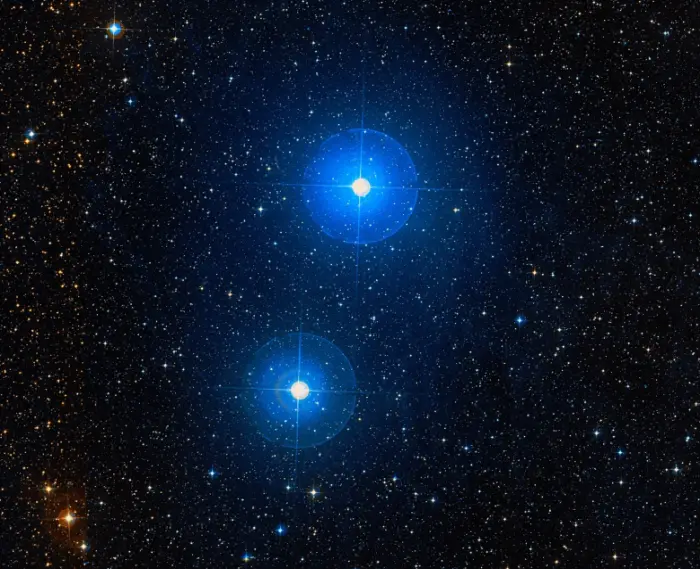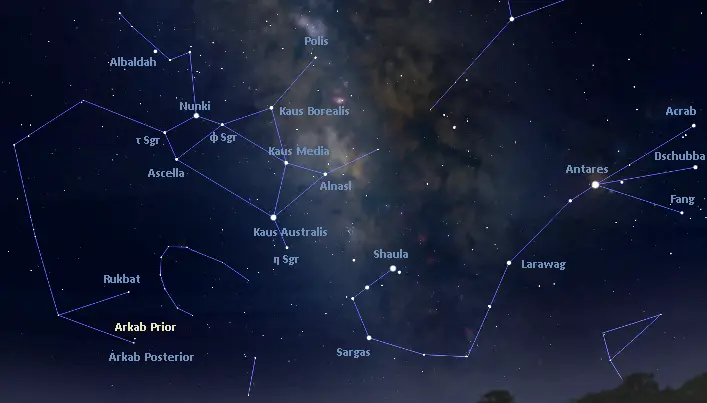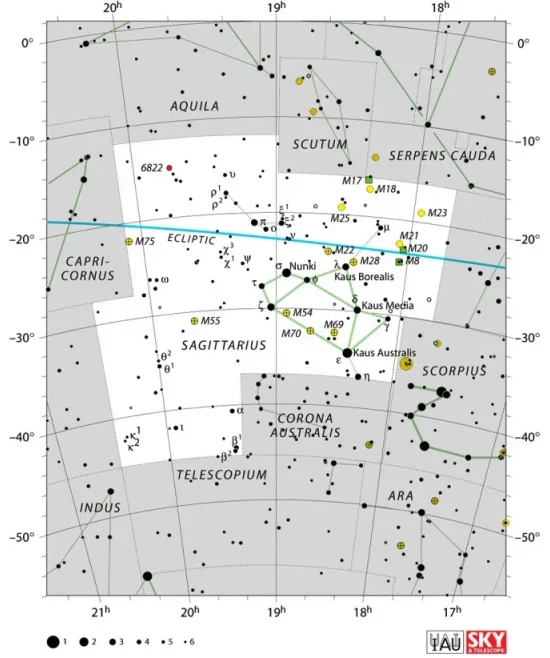Arkab Prior, Beta1 Sagittarii (β1 Sgr), is a binary star located approximately 310 light-years away in the constellation Sagittarius. With an apparent magnitude of 4.01, it is faintly visible to the unaided eye. The star system appears in the foot of the celestial Archer.
Star system
Beta1 Sagittarii is a binary star system composed of a hot blue main sequence star of the spectral type B9 V and a white main sequence star with the stellar classification A5 V. The two components are separated by 28.3 arcseconds, corresponding to a physical separation of around 3,290 astronomical units (AU).
The primary component, Beta1 Sagittarii A, is formally named Arkab Prior. The star has a mass 3.67 times that of the Sun and a radius 2.73 times the Sun’s. With a surface temperature of 11,960 K, it is 324 times more luminous than the Sun. It spins with a projected rotational velocity of about 85 km/s. The star has an estimated age of 224 million years.
Even though it is much younger than the Sun, Arkab Prior is around 95% of the way of its main sequence lifetime. It is not massive enough to be a supernova candidate. Instead, it will end its life by expelling its outer gaseous envelope to form a planetary nebula and then gradually fading as a white dwarf.
The companion, Beta1 Sagittarii B, has a radius of 1.89 solar radii. The star is a fast spinner, with a projected rotational velocity of around 140 km/s. With a visual magnitude of 7.4, it is not visible to the unaided eye.
The brightness of the Beta1 Sagittarii system is reduced by an extinction factor of 0.17 in the visual band.
The Simbad database lists Beta1 Sagittarii as a pulsating variable, a star that exhibits brightness variations because its surface pulsates. The star’s brightness has been reported to vary only slightly, with an amplitude of 0.01 mag.

Arkab Prior (Beta¹ Sagittarii), image credit: ESO/Digitized Sky Survey 2 (CC BY 4.0)
Facts
Arkab Prior shares the Bayer designation Beta Sagittarii with the slightly fainter Arkab Posterior (Beta2 Sagittarii). The two star systems are separated by about 0.36 degrees in the sky. Arkab Posterior is a cooler and older F-type star that lies much closer to us, at a distance of 134 light-years. Even though it is much more distant, Arkab Prior appears brighter because it is much more massive and therefore more intrinsically luminous. It is the northwestern of the two stars.
In Arabic astronomy, Arkab Prior, Arkab Posterior and Rukbat were known as Al Suradain, the two Surad (desert birds).
Name
The name Arkab Prior (pronunciation: /ˈɑːrkæb ˈpraɪər/) means “the front Achilles tendon.” The word Arkab is derived from the Arabic Al ‘Urkub (“Achilles tendon”) and prior is Latin for “front” or “foremost.” The International Astronomical Union’s (IAU) Working Group on Star Names (WGSN) formally approved the name on October 5, 2016. The name applies only to the primary component, Beta1 Sagittarii A, but has traditionally been used for the whole star system.
In old Chinese astronomy, Arkab Prior was known as 天淵二 (Tiān Yuān èr), the Second Star of Celestial Spring. It formed the Celestial Spring asterism with Rukbat (Alpha Sagittarii) and Arkab Posterior (Beta2 Sagittarii). The asterism was part of the larger Dipper mansion, one of the northern mansions of the Black Tortoise. It represented a pond in the sky.

Arkab Prior and Arkab Posterior, image credit: ESO/Digitized Sky Survey 2 (CC BY 4.0)
Location
Arkab Prior and Arkab Posterior lie in the southern part of Sagittarius, near the border with the constellations Telescopium (the Telescope) and Corona Australis (the Southern Crown). The stars can be found by extending a line from Alnasl (Gamma2 Sagittarii) through Kaus Australis (Epsilon Sagittarii) in the Teapot asterism past the semi-circle of the Southern Crown. The slightly fainter Arkab Posterior lies southeast of Arkab Prior, right next to the border with Telescopium.
At declination -44° 28’, Arkab Prior is best seen from the southern hemisphere. It never rises for observers north of the latitude 45° N and barely shows up above the horizon for observers in the mid-northern latitudes.

Arkab Prior location, image: Stellarium
Constellation
Arkab Prior is located in the southern constellation of Sagittarius. The celestial Archer is one of the 12 zodiac constellations, located on the ecliptic (the Sun’s apparent path across the sky). It occupies 867 square degrees of the sky south of the celestial equator and is the 15th largest of the 88 modern constellations.
With seven stars brighter than magnitude 3.0, Sagittarius is one of the most conspicuous southern constellations. Its eight bright stars form the Teapot, an asterism that lies next to the Milky Way’s bright band.
Kaus Australis (Epsilon Sagittarii), the constellation’s brightest star, is a blue subgiant with an apparent magnitude of 1.85 that lies 143 light-years away. The fast-spinning oblate star marks the southern end of the Archer’s bow. It forms the bow with the orange giants Kaus Media (Delta Sagittarii) and Kaus Borealis (Lambda Sagittarii).

Sagittarius constellation map by IAU and Sky&Telescope magazine (Roger Sinnott & Rick Fienberg) (CC BY 3.0)
Nunki (Sigma Sagittarii), the second brightest star in Sagittarius, is part of the Little Milk Dipper, a star pattern formed by five stars that also outline the left side of the Teapot. Nunki is a massive blue main sequence star that shines at magnitude 2.05 from a distance of 228 light years.
Other bright stars in Sagittarius include the triple stars Zeta Sagittarii (Ascella) and Nu1 Sagittarii (Ainalrami), the orange giants Tau Sagittarii and Alnasl (Gamma2 Sagittarii), the blue supergiant Polis (Mu Sagittarii), the blue main sequence star Rukbat (Alpha Sagittarii), and the white subgiant Albaldah (Pi Sagittarii).
The constellation also hosts some of the largest and most luminous stars known in our Milky Way galaxy. These include the luminous blue variable known as the Pistol Star, the Wolf-Rayet star WR 102ka (the Peony Star), and the red supergiants KW Sagittarii and VX Sagittarii.
Other notable stars in Sagittarius include the nearby M-type dwarf Ross 154, the Pinwheel Star (WR 104), and the born-again star known as Sakurai’s Object (V4334 Sagittarii).
Sagittarius contains many bright nebulae and star clusters that can be observed in small telescopes. These include the Lagoon Nebula (M8), the Omega Nebula (M17), the Trifid Nebula (M20), the open star clusters M18, M23 and M25, and the globular clusters M28, M54, M55, M70 and M75.
The Milky Way’s central supermassive black hole, Sagittarius A*, lies in the direction of Sagittarius, as do the massive open clusters known as the Quintuplet Cluster and the Arches Cluster near the Galactic centre. Other notable deep sky objects in the constellation include Barnard’s Galaxy (NGC 6822), the Sagittarius Dwarf Elliptical Galaxy, the globular clusters NGC 6544 and the Chandelier Cluster (NGC 6723), and the planetary nebulae known as the Red Spider Nebula (NGC 6537), the Little Gem Nebula (NGC 6818), the Box Nebula (NGC 6445), and the Eye of Sauron Nebula (M1-42).
The best time of the year to observe the stars and deep sky objects in Sagittarius is during the month of August, when the celestial Archer appears higher above the horizon in the early evening. The entire constellation can be seen from locations south of the latitude 55° S.
The 10 brightest stars in Sagittarius are Kaus Australis (Epsilon Sgr, mag. 1.85), Nunki (Sigma Sgr, mag. 2.05), Ascella (Zeta Sgr, mag. 2.59), Kaus Media (Delta Sgr, mag. 2.70), Kaus Borealis (Lambda Sgr, mag. 2.82), Albaldah (Pi Sgr, mag. 2.89), Alnasl (Gamma² Sgr, mag. 2.98), Eta Sagittarii (mag. 3.11), Phi Sagittarii (mag. 3.17), and Tau Sagittarii (mag. 3.326).
Arkab Prior – Beta1 Sagittarii
| Spectral class | B9 V + A5 V |
| Variable type | Pulsating variable |
| U-B colour index | -0.39 |
| B-V colour index | -0.10 |
| Apparent magnitude | 4.01/7.4 |
| Absolute magnitude | -1.32 |
| Distance | ~ 310 light-years (100 parsecs) |
| Parallax | 8.3782 ± 0.6299 mas |
| Radial velocity | −10.7 ± 2.7 km/s |
| Proper motion | RA: +2.890 ± 0.753 mas/yr |
| Dec.: −18.125 ± 0.529 mas/yr | |
| Mass (β1 Sgr A) | 3.67 ± 0.14 M☉ |
| Luminosity (β1 Sgr A) | 324 L☉ |
| Radius (β1 Sgr A, β1 Sgr B) | 2.73 R☉, 1.89 R☉ |
| Temperature (β1 Sgr A) | 11,960 K |
| Metallicity (β1 Sgr A) | -0.35 |
| Age (β1 Sgr A) | 224 million years |
| Rotational velocity (β1 Sgr A, β1 Sgr B) | 85 ± 13 km/s, 140 ± 21 km/s |
| Surface gravity (β1 Sgr A) | 3.83 cgs |
| Constellation | Sagittarius |
| Right ascension | 19h 22m 38.2992119424s |
| Declination | −44° 27′ 32.250184884″ |
| Names and designations | Arkab Prior, Beta1 Sagittarii, Beta1 Sgr, β1 Sagittarii, β1 Sgr, HD 181454, HR 7337, HIP 95241, SAO 229646, FK5 1502, PPM 325041, CD−44°13277, CPD-44 9548, CPC 0 18125, GC 26703, GCRV 11812, CSI-44 13277 21, SKY# 36026, GEN# +1.00181454, GEN# +1.00181454A, GSC 07943-02105, N30 4289, ROT 2774, UBV 16358, UBV M 23680, uvby98 100181454 A, uvby98 100181454, WEB 16640, TIC 62119727, TYC 7943-2105-1, IRAS 19190-4433, 2MASS J19223828-4427326, WISE J192238.30-442732.4, WISEA J192238.30-442732.2, Gaia DR2 6664464851575462016, Gaia DR3 6664464851576141824, CCDM J19226-4428A, IDS 19154-4439 A, WDS J19226-4428A |